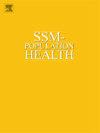美国的医疗保险:有效维持不平等的案例?
IF 3.6
2区 医学
Q1 PUBLIC, ENVIRONMENTAL & OCCUPATIONAL HEALTH
引用次数: 0
摘要
有效维持不平等(EMI)理论(Lucas,2001 年)认为,商品既有量的方面(多少?再加上假设的 EMI 机制,这一简单的观察结果使有关不平等的研究和政策制定变得更加复杂。该理论最初被用于解释美国的教育不平等现象,目前已在智利、中国、捷克、丹麦、埃及、德国、希腊、爱尔兰、尼日利亚、南非和韩国等 20 多个国家的教育系统中找到了证据。然而,虽然 EMI 是作为不平等的一般理论提出的,但迄今为止,还没有任何研究对其在教育以外领域的适用性进行过评估。本研究利用近二十年的全国健康访谈调查数据(N = 451,161 ),以美国的医疗保险问题为切入点,首次尝试评估 EMI 是否能揭示教育以外的不平等模式。本文章由计算机程序翻译,如有差异,请以英文原文为准。
Health insurance in the United States: A case of effectively maintained inequality?
The theory of Effectively Maintained Inequality (EMI) (Lucas, 2001) posits that goods have both quantitative (how much?) and qualitative (what kind?) dimensions. Coupled with the hypothesized mechanisms of EMI, this simple observation greatly complicates research and policy development concerning inequality. First applied to explain educational inequality in the United States, evidence for the theory has been found in education systems in over 20 countries, including Chile, China, the Czech Republic, Denmark, Egypt, Germany, Greece, Ireland, Nigeria, South Africa, and South Korea. Yet, while EMI was proposed as a general theory of inequality, to date no research has assessed its applicability to domains outside education. This work uses nearly two decades of National Health Interview Survey data (N = 451,161) to provide the first effort to assess whether EMI illuminates patterns of inequality outside education, by taking up the issue of health insurance in the United States.
求助全文
通过发布文献求助,成功后即可免费获取论文全文。
去求助
来源期刊

Ssm-Population Health
PUBLIC, ENVIRONMENTAL & OCCUPATIONAL HEALTH-
CiteScore
6.50
自引率
2.10%
发文量
298
审稿时长
101 days
期刊介绍:
SSM - Population Health. The new online only, open access, peer reviewed journal in all areas relating Social Science research to population health. SSM - Population Health shares the same Editors-in Chief and general approach to manuscripts as its sister journal, Social Science & Medicine. The journal takes a broad approach to the field especially welcoming interdisciplinary papers from across the Social Sciences and allied areas. SSM - Population Health offers an alternative outlet for work which might not be considered, or is classed as ''out of scope'' elsewhere, and prioritizes fast peer review and publication to the benefit of authors and readers. The journal welcomes all types of paper from traditional primary research articles, replication studies, short communications, methodological studies, instrument validation, opinion pieces, literature reviews, etc. SSM - Population Health also offers the opportunity to publish special issues or sections to reflect current interest and research in topical or developing areas. The journal fully supports authors wanting to present their research in an innovative fashion though the use of multimedia formats.
 求助内容:
求助内容: 应助结果提醒方式:
应助结果提醒方式:


